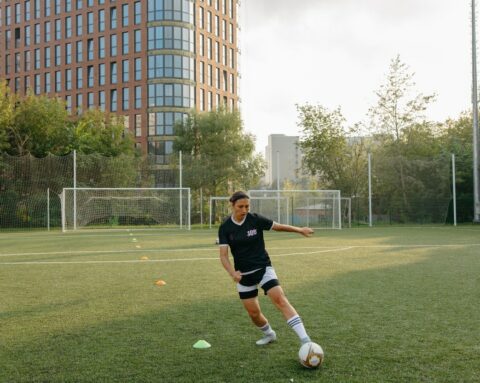The most durable basketball superstar of all time, Lebron James has marvelled medical experts for
years with his ability to bounce back from injury, play on days where others need rest and perform
to his peak so consistently. Since 2010 Lebron James has played more than 25,000 minutes of
basketball greatly eclipsing any other basketballer in the same time period. Sure, he has a great diet,
access to the best technology and gear but the one thing Lebron James always stresses is that he is
always recovering. From the moment the game ends until the following game Lebron James is using
active recovery techniques to ensure he is at his absolute best.
It may seem counterintuitive initially to think that on your rest days you should actually be
exercising! However, modern scientific evidence suggests that active recovery is vital for improving
one’s mental state improving endurance levels. The term active recovery is defined as performing
exercises at low intensity after or during a workout to clear out toxins associated with muscle
damage and increase blood flow. For example, if you are a runner that performs in 10k runs it is far
more beneficial on your off days to do some light exercise bike riding and foam rolling rather than
just lying down on the couch.
The first opportunity for active recovery occurs directly after the workout. Professional sporting
teams are often seen performing a light warm-down routine after the game. The primary goal of the
cool-down period is to keep your heart rate elevated above resting rate. This period of warm down
should last for at least 5-10 minutes to gain the maximum benefits. If your sport of choice involved
heavy cardio than low resistance training followed by a flexibility exercise such as yoga can be
extremely beneficial. Conversely, if you partook in an exercise than revolved around lifting heavy
weights than it would be far more useful to do some high-intensity walking or slow jogging.
One aspect that definitely shouldn’t be overlooked when discussing recovery is sleep. It is incredibly
important to get as much sleep as possible to allow your muscles the best chance of recovery. A
minimum of 7 hours is required to feel the full effects the next day. When we sleep, the high-quality
food we consume during the day is used to build and repair muscle. The brain is also able to
recharge and prepare for the day ahead. Sometimes after exercising it can be difficult to fall asleep,
it is therefore recommended to finish your exercise around 4-6 hours before you wish to go to sleep.
It is incredibly important to listen to your body when partaking in active recovery. When recovering,
the nervous system responsible for calming your body is stimulated which allows the body to relax,
rest and restore carbohydrate levels. After we exercise our body experiences a certain amount of
inflammation which can take around 3 days to recover. It is important to take a minimum of 1-2 days
per week where you do not over exert yourself. Whilst we are recommending that you prioritise
active recovery it is important to note that if your body tells you that you need a full day of rest, to
take one.
The second opportunity for active recovery occurs the day following the exercise. When recovering
from an intense session of exercise it is good to mix up your recovery methods, ensuring the cover
all the muscle groups that you used in the prior workout. Some of the best methods for active
recovery are using foam rollers, swimming and yoga.
Swimming is an incredibly good activity the day after exercise as it is a low-stress option. Swimming
engages both the cardiovascular system and the muscular system without putting to much pressure
on the joints. Ocean and lake swimming can be just as effective as swimming in a pool however it is
important to be mindful of your swimming capabilities and fitness levels before choosing this active
recovery method.
Another awesome method for active recovery days is to use a foam roller. Foam rolling is a form of
myofascial release which is a safe and hands-on technique that involves applying gentle, sustained
pressure into the myofascial connective tissue restrictions to eliminate pain and restore motion.
Foam rolling is great for improving joint range of motion and releasing tight muscles. On active
recovery days, it is best to roll over all the major muscle groups for 30-60 seconds each.
Low impact yoga is a fantastic way to improve muscular flexibility, improve joint range of motion and
stretch tight muscles. When recovering our muscles, it is crucial to find activities that engage in
lower impact less intense exercise and yoga fits this description perfectly. When partaking in yoga it
is important to work with your physical therapists’ recommendations and ensure you are staying
within your pain-free limits.
When working on devising the perfect active rest day plan it is crucial to consider the parts of our
bodies that are involved in every just about every single exercise known to humankind. Our pelvis
and core are deeply neglected aspects of most training platforms. These muscles are quite small,
however, offer incredible amounts of control and stabilisation of the pelvis and spine. Building
strength in these muscles will help with everyday life as well as intense training regimes.
Athletes need to psychologically and physically recover from the intense stress of competing and
training whilst still maintaining their high fitness levels. With all the research we now have access to,
active recovery must become a key portion of any person’s days off. Our skilled therapists can assist
you in creating the perfect recovery plan including which exercises will have the most benefit for the
exercise of your choice. With the integration of professionally planned active rest days as well as any
required myotherapy, massage and cupping you will be able to perform at your peak more
consistently and with a lower chance of injury or re-injury. Contact us today to feel better, faster
after your exercise sessions!






